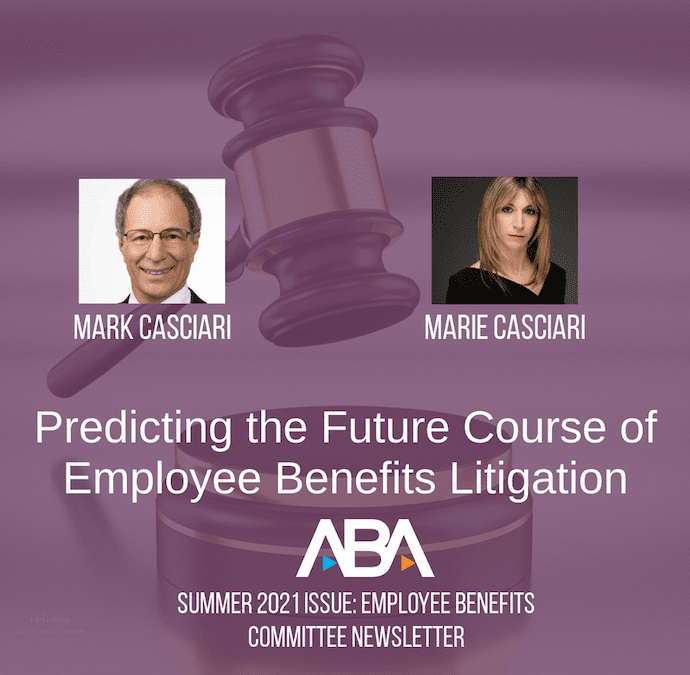There is no shortage of new and interesting employee benefits court decisions. And there is no shortage of new and interesting decisions that do not directly impact employee benefits but have a significant indirect impact.
We are two employee benefits attorneys who have practiced on each side of the “v.” – representing plaintiffs and defendants. We note the decisions that we think deserve your attention, and humbly predict where employee benefits litigation is heading.
Table of Contents
A. Standing
The U.S. Constitution’s Article III preconditions all federal court litigation, including of course ERISA litigation, on standing. Just over a year ago, the Supreme Court issued its decision in Thole v. U.S. Bank N.A., [1] wherein plaintiffs alleged a mismanagement of defined benefit plan funds that resulted in an approximate $750 million loss. The Court found that the employees lacked Article III standing because they “received all of their monthly benefit payments so far, and the outcome of this suit would not affect their future benefit payments.” [2] The Court “emphasized that Article III standing requires a concrete injury even in the context of a statutory violation;”[3] and added that “[t]here is no ERISA exception to Article III.”[4]
Then, in California v. Texas [5], the Supreme Court addressed the third judicial challenge to the Affordable Care Act (ACA). The Court found that the plaintiffs lacked Article III standing to challenge the constitutionality of the ACA after Congress reduced the individual penalty for failing to obtain minimum essential healthcare coverage to $0. The Court found that “[n]either the individual nor the state plaintiffs have shown that the injury they will suffer or have suffered is fairly traceable to the allegedly unlawful conduct of which they complain,”[6] so they “failed to show a concrete, particularized injury fairly traceable to the defendants’ conduct in enforcing the specific statutory provision they attack as unconstitutional.”[7]
And then, just two weeks later, the Supreme Court once again addressed Article III standing in TransUnion LLC v. Ramirez [8]. In Ramirez, the plaintiff class claimed that TransUnion failed to ensure the accuracy of the information contained in their credit files. The class consisted of more than 8,000 individuals, but less than 2,000 credit files were actually provided to third parties. The Court found that only those individuals whose credit information had been shared with others demonstrated concrete harm and had standing to sue. The Court stated that “the mere existence of inaccurate information in a database is insufficient to confer Article III standing.”[9]
There also have been some significant Courts of Appeal decisions on standing in ERISA cases. In Gonzalez de Fuente v. Preferred Home Care of N.Y. LLC,[10] the Second Circuit upheld the dismissal of a suit brought under Section 502(a)(2) and (a)(3) that alleged the misappropriation of employer contributions and plan funds. The plaintiffs did not claim that they had been denied benefits due under the plan or that the plan was incapable of continuing to provide benefits. Relying heavily on Thole, the Second Circuit likened a group healthcare plan to a defined benefit plan and concluded that “[b]ecause winning or losing on their ERISA claims would not change the plaintiffs’ [health] benefits, they have no concrete stake in this dispute and therefore lack Article III standing.”[11]
Standing has also been raised in Wit v. United Behavioral Health,[12] which is currently pending in the Ninth Circuit. Wit involved a class of approximately 67,000 participants in group healthcare plans. The district court found that UBH’s guidelines for assessing mental health treatment claims were inconsistent with generally accepted standards of care and remanded the claims for reprocessing under appropriate criteria. The district court found that because each class participant claim was denied, the claimants had suffered a concrete injury sufficient to establish Article III standing. The Secretary of Labor recently filed an amicus brief supporting the plaintiff-appellees to “ensur[e] that participants and beneficiaries challenging coverage denials…are not denied access to court based on a cramped investigation of standing principles.”[13] We all should pay attention to any ruling on standing by the Ninth Circuit.
In contrast to Wit, in Smith v. Health Care Serv. Corp.,[14] another district court in the Seventh Circuit dismissed a similar complaint alleging that other mental health treatment guidelines are inconsistent with generally accepted standards of care because of a lack of standing. The court cited Thole and reasoned that the Smith plaintiffs alleged only “a bare incursion on the purported statutory right to more generous medical necessity guidelines with regard to residential treatment services,” and had not shown that benefits were improperly denied on account of such guidelines. The district court concluded that there was no concrete injury.[15]
Trend Line. Expect more challenges to federal court employee benefits complaints in the class action or plan relief context based on Article III standing. Query whether district courts may even hear evidence on the issue or allow some limited discovery before ruling. And query whether plaintiffs (to the extent not relying on exclusive Section 502(a)(2) or (3) federal court claim jurisdiction) may resort more to state courts, where standing rules do not derive from Article III.[16]
B. Preemption
Another evolving issue is the scope of ERISA preemption. The Supreme Court’s 2016 decision in Gobeille v. Liberty Mut. Ins. Co.[17] strengthened ERISA’s preemption provision in Section 514(a). The majority decision was written by Justice Kennedy, who is now retired.
The new composition of the Court seems less enamored with ERISA preemption. In Rutledge v. Pharm. Care Mgmt. Ass’n,[18] the Court held that an Arkansas statute regulating the reimbursement rates paid by pharmacy benefit managers to local pharmacies was not preempted by ERISA. Citing New York State Conf. of Blue Cross & Blue Shield Plans v. Travelers Ins. Co.,[19] the Court reasoned that state rate regulations that merely increase costs for ERISA plans without forcing plans to adopt a particular scheme of substantive coverage are not preempted.
Since Rutledge, there have been two other significant preemption cases decided at the Court of Appeals level. First, in ERISA Indus. Comm. v. City of Seattle,[20] the Ninth Circuit held that a health benefits ordinance requiring hotel employers and ancillary businesses to provide money to designated employees or include those employees in its employer-sponsored healthcare plans did not “relate to” employee benefit plans in a manner that triggered preemption. The Ninth Circuit reasoned that the city ordinance did not require that employers make payments to an ERISA plan, but instead allowed payments to the covered employee directly. A rehearing request is currently pending as of this writing. The rehearing argument is that the Ninth Circuit’s Golden Gate Rest. Ass’n v. San Francisco decision[21] conflicts with First and Fourth Circuit precedent and is no longer good law.
A couple of months later, in Howard Jarvis Taxpayers Ass’n v. Cal. Secure Choice Ret. Sav. Program,[22] the Ninth Circuit held that a California law establishing a state-managed individual retirement program, known as CalSavers, was not preempted. The Ninth Circuit found that a state-run retirement program is not an ERISA plan “established or maintained by an employer.” Instead, the program applied only when eligible employers in the State failed to provide their employees with other reasonable retirement savings options. The court rejected arguments that CalSavers “relates to” ERISA benefit plans, reasoning that it regulates neither ERISA plans nor plan benefits. The indirect economic effects on employer benefits offerings because of CalSavers were not enough to establish preemption. Approximately half a dozen other states and cities have instituted similar state-run retirement programs, so stay tuned.
Trend Line. Expect to see more benefits-related laws passed at the state and local level. One example is a recent law passed by the State of Washington establishing the first state-operated long-term care program, which will be funded through a mandatory payroll tax. And expect strong opposition to preemption arguments.
C. Arbitration
In Munro v. Univ. of S. Cal.,[23] the Ninth Circuit refused to compel arbitration of breach of fiduciary duty claims brought under Section 502(a)(2) even though the individual employees signed arbitration agreements as part of their employment contracts. The court explained that “[b]ecause the parties consented only to arbitrate claims brought on their own behalf, and because the Employees’ present claims are brought on behalf of the Plans, we conclude that the present dispute falls outside the scope of the agreements.”[24] But, in Dorman v. Charles Schwab Corp.,[25] the Ninth Circuit overturned a district court’s denial of a motion to compel individual arbitration of ERISA fiduciary breach claims under Section 502(a)(2) based on an arbitration provision included in the plan.
This year, in Cooper v. Ruane Cunniff & Goldfarb Inc.,[26] the Second Circuit overturned a district court’s order compelling arbitration in another case alleging breach of fiduciary duty claims under Section 502(a)(2). The arbitration provisions were contained in the employee handbook distributed to and signed by new employees, but in none of the operative plan documents or investment agreements. The Second Circuit found that the arbitration provisions did not apply because the ERISA claims did not arise out of or relate to employment. The Second Circuit held “that, in the context of an employment arbitration agreement, a claim will ‘relate to’ employment only if the merits of that claim involve facts particular to an individual plaintiff’s own employment.”[27]
Most recently, in Smith v. Bd. of Dirs. of Triad Mfg., Inc.,[28] the Seventh Circuit declined to compel arbitration under an arbitration clause in a defined contribution plan. The court determined that ERISA claims are generally arbitrable, but the arbitration provision at issue was not enforceable. The plaintiffs sought plan-wide relief under Section 502(a)(2), but the terms of the arbitration provision precluded them from seeking any relief that “has the purpose or effect of providing additional benefits or monetary or other relief to any Eligible Employee, Participant or Beneficiary other than the Claimant.”[29] The court explained that “[i]n that way, the plan’s arbitration provision acts as a prospective waiver of a party’s right to pursue statutory remedies, so the effective vindication exception applies.”[30] The court distinguished Dorman based on the language of the arbitration clause at issue in that case, and concluded that its “holding turns on the impermissible relief, and not the chosen vehicle, for ERISA claims.”[31]
Trend Line. It is possible the Federal Arbitration Act will be amended to moot the current spate of court decisions addressing whether to compel arbitration. Until that happens, though, expect more litigation on whether arbitration can take the place of federal litigation in the employee benefits context. Decisions like Smith and Dorman also highlight the significance of plan drafting.
D. Forum Selection Clauses
This year, the Ninth Circuit became the third Court of Appeals to uphold the enforcement of forum selection clauses in employee benefit plans. Section 502(e)(2) provides that a legal action may be brought under ERISA “in the district where the plan is administered, where the breach took place, or where a defendant resides or may be found.” In Becker v. U.S. Dist. Ct.,[32] the Ninth Circuit followed the decisions of the Sixth and Seventh Circuits[33] in finding that a forum selection clause contained in a 401(k) plan was enforceable. The Ninth Circuit found that “[n]either ERISA’s language and purpose nor precedent invalidates the Plan’s forum selection clause.”[34] The court also cited Dorman, supra, and explained that a forum selection clause “guarantees venue in a federal court,” but “a federal court is not even required. Wells Fargo might have foreclosed access to any federal court through an arbitration clause.”[35]
Trend Line. Expect more employee benefit plans to include forum selection clauses among plan terms, and perhaps less litigation over their legality, depending on the precise terms, after the Becker decision.
E. Strict Statutory Construction
The Supreme Court seems more inclined as a general matter to engage in strict statutory construction. The recent decision in Sanchez v. Mayorkas[36] involved a man who entered the United States unlawfully but was later granted Temporary Protected Status (TPS) because of the unsafe living conditions in his country of origin. The Supreme Court upheld the denial of the petitioner’s application to become a lawful permanent resident (LPR) because he initially entered the United States illegally. The Court reasoned that while a person’s unlawful entry would not typically preclude the granting of TPS, the relevant statutory provisions require that an LPR applicant originally entered the country lawfully. The conferral of TPS did not eliminate that requirement or confer lawful admission, so “[a] straightforward application of § 1255 thus supports the Government’s decision to deny him LPR status.”[37]
Although Sanchez was not an ERISA case, the decision was unanimous, and thus seems to signal the Court’s willingness to strictly interpret any statutory language at issue, even in the face of arguably compelling public policy arguments to the contrary.
Trend Line. Expect an increasing unwillingness of the courts to read ERISA, or any employee benefits statute, beyond its clear language. And expect the plan language to acquire a greater significance in the days ahead. When drafting ERISA plans, it is important to write well.
F. Cases to Watch
This article aims to survey the employee benefits litigation scene to highlight the critical legal issues making their way through the courts today (without making any comment on the future of Department of Labor investigations and lawsuits). There is still a lot to be seen. We eagerly await the Ninth Circuit’s ruling in Wit regarding the standing and other class certification issues in the healthcare context, as well as the Seventh Circuit’s arbitration rulings in Smith and Hensiek. And we await the Supreme Court’s decision next term in Hughes v. Northwestern Univ.,[38] which should provide yet further insight into how the Court expects lower courts to view plan participant defined contribution fee and investment claims in the context of motions to dismiss, before opening the door to expensive discovery.
This article, co-authored by Marie Casciari, DeBofsky Law, and Mark Casciari, Seyfarth Shaw LLP, was first published in the ABA, Labor & Employment Law Section, Employee Benefits Committee Summer 2021 Newsletter.
[1] 140 S. Ct. 1615 (2020).
[2] Id. at 1619.
[3] Id. at 1620-21 (quoting Spokeo, Inc. v. Robins, 136 S. Ct. 1540, 1549 (2016); internal quotation marks omitted).
[4] Id. at 1622.
[5] 141 S. Ct. 2104 (2021).
[6] Id. at 2113.
[7] Id. at 2120 (internal quotation marks omitted).
[8] 141 S. Ct. 2190 (2021).
[9] Id. at 2209.
[10] No. 20-3985-cv, 2021 WL 2308786, 2021 U.S. App. LEXIS 16814, __Fed. App’x__ (2d Cir. June 7, 2021).
[11] 2021 U.S. App. LEXIS 16814, at *5 (quoting Thole, 140 S. Ct. at 1622; internal quotation marks omitted).
[12] No. 14-cv-02346, 2019 WL 1033730, 2019 U.S. Dist. LEXIS 35205 (N.D. Cal. Feb. 28, 2019) (findings of fact and conclusions of law); 2020 WL 6479273, 2020 U.S. Dist. LEXIS 205435 (N.D. Cal. Nov. 3, 2020) (remedies order).
[13] No. 20-17363 (May 19, 2021), ECF No. 55 at 8.
[14] No. 19 C 7162, 2021 WL 963814, 2021 U.S. Dist. LEXIS 47997 (N.D. Ill. Mar. 15, 2021).
[15] 2021 U.S. Dist. LEXIS 47997, at *15 (internal quotation marks omitted).
[16] However, plaintiffs cannot assert any ERISA claims in state court besides Section 502(a)(1)(B) claims.
[17] 577 U.S. 312 (2016).
[18] 141 S. Ct. 474 (2020).
[19] 514 U.S. 645 (1995).
[20] 840 Fed. App’x 248 (9th Cir. 2021).
[21] 512 F.3d 1112 (9th Cir. 2008).
[22] 997 F.3d 848 (9th Cir. 2021).
[23] 896 F.3d 1088 (9th Cir. 2018).
[24] Id. at 1092.
[25] 780 Fed. App’x 510 (9th Cir. 2019).
[26] 990 F.3d 173 (2d Cir. 2021).
[27] Id. at 184.
[28] No. 20-2708, 2021 WL 4129456, 2021 U.S. App. LEXIS 27312 (Sept. 10, 2021).
[29] 2021 U.S. App. LEXIS 27312, at *2.
[30] Id. at *18 (quoting Mitsubishi Motors Corp. v. Soler Chrysler-Plymouth, Inc., 473 U.S. 614, 637, n. 19 (1985); internal quotation marks omitted).
[31] Id. at *19.
[32] 993 F.3d 731 (9th Cir. 2021).
[33] Smith v. AEGON Cos. Pension Plan, 769 F.3d 922 (6th Cir. 2014); In re Mathias, 867 F.3d 727 (7th Cir. 2017).
[34] Becker, 993 F.3d at 732.
[35] Id.
[36] 141 S. Ct. 1809 (2021).
[37] Id. at 1813.
[38] No. 19-1401, 2021 WL 2742780, 2021 U.S. LEXIS 3583, __S. Ct.__ (July 2, 2021).







